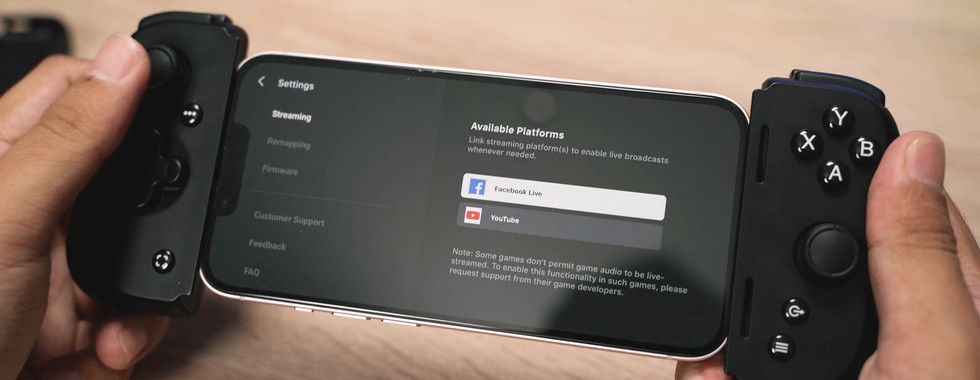Razer Kishi V2 for iPhone Review: Not Good Enough For My EDC
- Soon Kai Hong
- Oct 25, 2022
- 6 min read
The Razer Kishi V2 is a little bit of a polarising product for me. On one hand, I do quite like some of the major improvements it has over the original but on the other hand, it removes some of the best features the original had. To cut straight to the chase, while I do quite like it, it’s not going to be part of my EDC (EveryDay-Carry).
Now let’s go over the design of the Kishi V2 because this is quite the huge departure from the original V1.
Design
As you would expect, you get everything that you should from a mobile controller.

You have your two thumbsticks positioned asymmetrically, the XYAB cluster, the D-Pad, a number of secondary function buttons and of course, bumpers triggers on both the left and right. Pretty standard thus far but that’s not all because you do also get a couple of additional multi-function buttons located right beside the triggers aptly named L4 and R4 which are fully reprogrammable, giving you additional control.
And because this is the iPhone edition, you will get a Lightning connector which inserts into your iPhone, keeping it snug and tight and you’ll still be able to charge it via the Lightning passthrough port located on the bottom right.
Buttons, Switches & Triggers
But more on those buttons because this is a key highlight of the Kishi V2. Razer touts the use of microswitches for the XYAB cluster as well as mechanical clicks for the D-Pad which provides really great tactile feedback and extremely fast response thanks to the short button travel distance.

Honestly they feel really great to press on and it does make for a much more tactile and hands on experience during intense gameplay and the audible clicks does ensure that your inputs are registered as fast as you possibly can. Depending on the genre that you play most, this might be a huge advantage especially in a competition environment. The same microswitches can also be found for the bumpers and multi-function button which feel just as great. Extremely satisfying to say the least.

But perhaps the biggest upgrade might be the triggers for they are now analog in nature and Razer has really nailed down the pressure curve to provide a distinctly superior experience compared to most of the competition, and especially from their previous V1. I don’t really know what to say except for the fact that it just feels right, exactly what I want a trigger to be. In addition, the new matte finish is so much better compared to the glossy finish of the previous not only in terms of feel but durability as well.

But by now you would’ve probably noticed that the overall silhouette of the Kishi V2 looks somewhat familiar to the Backbone One and yes, it does also operate in similar fashion. It is a fixed design featuring a stable bridge that can be extended to fit basically up to the largest iPhone 14 Pro Max with no issues at all. It is also worthy to note that there is quite a bit of clearance of not just your iPhone but with a case as well and depending on the thickness of your case, you can either swap out or remove the rubber padding underneath for added clearance.
Overall, the structural rigidity is certainly much better as compared to the V1 and it’s really comfortable in your hand. You can easily hold it on one side with one hand too, with no issues and even if you rage during your gaming sessions, it will hold up well. The grips themselves also feature a textured back to provide additional grip especially if sweat is a concern after hours of gaming,
As you can tell, I do quite like the Kishi V2 and in all the ways that I’ve just explained, it brings many advantages over the previous V1 to the table. However, it isn’t perfect and so let’s go over what I don’t really like about it.
The Not So Great Stuff
The biggest downgrade comes in the form of the two thumbsticks.

As you can probably tell, these are pretty much the same type of thumbsticks that you can find on the Nintendo Switch, competitors such as the Backbone One or even the JungleCat from Razer from quite some time before. They’re pretty small and don’t offer much resistance per se. Basically, they aren’t great and that’s especially apparent when comparing to the previous Kishi V1 which feature custom thumbsticks that are more akin to those found on the full-sized Xbox or PlayStation controllers.

Now you might think I’m exaggerating but I’m not. Just take any game that utilizes the thumbstick often and which requires accurate aim. You’ll find that the thumbsticks on the Kishi V2 just don’t perform well and you would miss your aim so much more than usual it’s not even a joke. If you’re a Ganyu main in Genshin Impact, prepare to suffer.
Now the next point is really… something that applies to the majority of Razer products as of late and that’s app support. With the Kishi V2, it utilises the Razer Nexus app and you can think of it as Steam Big Picture, but for mobile. In here, it’ll list games that might be to your liking according to genre and most of them would support a controller. Additionally, this is also where you can directly account and link it to Facebook Live or YouTube and is also where you can remap the controls and update the firmware for the Kishi V2.
It’s all pretty great stuff, so what’s the issue?

Well, the issue is the app itself. This is yet another app you have to download in order to use a specific Razer product. So right now, I have the Razer Audio app for my Barracuda Pro, I have the Chroma RGB app for my Leviathan V2, I have the Kishi app for the Kishi V1 and now this, the Nexus app for the Kishi V2.
And I’m not even going to talk about the Zephyr which has its own separate app.
It is getting kind of ridiculous and all I can say is Razer has to just make one unified app for everything. A Synapse Mobile that works just like how the desktop Synapse does. Now I hear that Razer might already be working on that, so that’s good to know but for now and the immediate future, it’s just so bad.

My last major gripe about the Kishi V2… is actually the design in itself. While the built-in extendable bridge is much more stable that the V1 in comparison, it doesn’t collapse that much for portability. Compared to the Kishi V1, the Kishi V2 is still quite a bit longer even when fully collapsed.
It might not look like much but it is the difference between having it comfortably in my pocket, or being able to fit in a small pouch in my bag. Additionally, because the bridge is exposed, you might be putting unwanted pressure right down the middle when you have loads of things in your bag packed like sardines. Especially for myself, where I tend to carry as light as possible, every little bit of space counts. Again, this last point might be divisive per se as it really depends on you, the user and what your lifestyle is like. But for myself, this just isn’t compact enough for my EDC.
Price
Fast forward a little, let’s talk about the price.

The Kishi V2 retails for S$149.90 or US$99.99 which is incidentally, the exact same price as the Backbone One. If you’re deciding between those two, it ultimately comes down to what you prioritise. If you prefer the Backbone app or if you like to have a 3.5mm jack, go with the Backbone One. If you like to have additional multi-function buttons that are reprogrammable or perhaps you like the tactility of the microswitches, go with the Razer Kishi V2.
But the bigger dilemma might be comparing getting the Kishi V2 or the Kishi V1. You can now easily find the Kishi V1 for a huge discount, going for about S$70 or US$50 thereabouts, which is basically half the price of the newer V2 and as mentioned, the thumbsticks are vastly superior which also collapsing into a much more compact form factor that’s much better suited for EDC or travel.
Thoughts
So, if you’re looking for a new mobile gaming controller, the Razer Kishi V2 certainly delivers but definitely do note that its direct competitor, Backbone, is offering just as much and there are pros and cons to either. Conversely, if you’re already an owner of the Kishi V1, we would say an upgrade is not necessary and if you’re looking at either of the Kishi(s), you do have to ask yourself if the V2 is worth twice the price.
Overall, the Razer Kishi V2 has been a joy to use but it wouldn’t be part of my EDC setup anytime soon.








